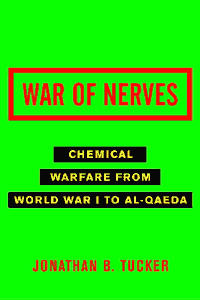
Chemical Warfare from World War I to Al-Qaeda
By Jonathan B. Tucker
War of Nerves is a detailed history for the general reader of the discovery, development, proliferation, and control of nerve agents such as Tabun, Sarin, Soman, and VX, the most lethal class of chemical weapons. These supertoxic poisons have no peaceful uses and, when inhaled or absorbed through the skin, are lethal in tiny amounts by disrupting the operation of the nervous system.
First discovered accidentally during the 1930s by industrial chemists in Germany conducting pesticide research, the nerve agents Tabun and Sarin were developed into chemical weapons and stockpiled by the Nazi regime. Fortunately, Hitler did not order their use during World War II because German intelligence believed--incorrectly--that the United States and the Soviet Union had developed similar weapons. After the war, the victorious Allies competed among themselves for the secrets of the Nazi nerve agent program. In the early 1950s, British industrial scientists accidentally discovered a second generation of nerve agents that were even more toxic than Sarin and were dubbed "V agents" because of their venomous (skin-penetrating) properties. During the Cold War, the United States and the Soviet Union pursued a chemical arms race in which they produced and stockpiled various nerve agents in the thousands of tons.
Beginning in the 1960s, the technology, materials, and know-how needed to manufacture nerve agents spread to the Middle East and other zones of conflict in the developing world. During the Iran-Iraq War of the 1980s, Saddam Hussein's Iraq was the first country to employ nerve agents on a large scale, initially against Iranian troops and then against its own Kurdish minority. In the early 1990s, the Japanese doomsday cult Aum Shinrikyo acquired the capability to produce nerve agents, ushering in a new era of chemical terrorism. On March 20, 1995, Aum members released a dilute solution of Sarin on the Tokyo subway, killing twelve people, injuring about a thousand, and terrifying millions. Today, al-Qaeda and related terrorist groups are seeking to acquire nerve agents, even as the 1993 Chemical Weapons Convention (CWC) banning the development, possession, and use of chemical arms is being implemented by some 175 member-states. Thus, the world is at a crossroads that could lead either to the further proliferation of these heinous weapons or to their ultimate abolition.
By illuminating the little-known history of nerve agents, War of Nerves provides important insights into current issues, including the 2003 Iraq War and the ongoing threat of chemical terrorism. Written in a lively narrative style, the book contains new historical information about the Soviet Union's secret development of "third-generation" nerve agents called Novichoks and the former U.S., British, and French nerve agent programs. War of Nerves is based on extensive research with primary sources, including declassified U.S. government documents obtained through the Freedom of Information Act; archives in the United States, Britain, Germany, and France; and interviews with individuals formerly involved in the U.S., British, and Soviet chemical weapons programs.
The author, Jonathan B. Tucker, Ph.D., is a Senior Fellow specializing in chemical and biological weapons in the Washington, D.C. office of the Monterey Institute's Center for Nonproliferation Studies (CNS). Before joining the CNS staff in March 1996, he served as an arms control specialist with the Department of State, the congressional Office of Technology Assessment, and the U.S. Arms Control and Disarmament Agency, where he worked on preparations for the entry into force of the Chemical Weapons Convention. In February 1995, he was a United Nations biological weapons inspector in Iraq. Dr. Tucker is the author of Scourge: The Once and Future Threat of Smallpox (Atlantic Monthly Press, 2001), which the Washington Post named a "best book" of 2001, and the editor of Toxic Terror: Assessing Terrorist Use of Chemical and Biological Weapons (MIT Press, 2000).
--------------------------------------------------------------------------------
Chapter Summaries
Prologue: "Live-Agent Training."
Learning to fight on a chemical battlefield, U.S. soldiers wearing gas masks and protective suits perform various tasks inside a sealed chamber contaminated with lethal amounts of nerve agents.
Chapter 1: "The Chemistry of War."
A vivid description of the advent of gas warfare in 1915 during the second battle of Ypres in World War I.
Chapter 2: "IG Farben."
German industrial chemist Gerhard Schrader, developing new pesticides, accidentally discovers the first supertoxic nerve agent, Tabun.
Chapter 3: "Perverted Science."
The Nazi regime develops Tabun and a related compound--Sarin--into chemical weapons, constructs large-scale plants for their production, and debates whether or not to use them in combat.
Chapter 4: "Twilight of the Gods."
As the Allied armies invade the Reich, Hitler orders the evacuation of his nerve-agent stockpile to prepare for a bloody last stand in the Bavarian Alps.
Chapter 5: "Fight for the Spoils."
In the immediate aftermath of World War II, the four victorious Allies compete for the secrets of the Nazi nerve agent program.
Chapter 6: "Research and Development."
In 1948, Col. Charles Loucks, an intelligence officer with the U.S. Army Chemical Corps, recruits German scientists to assist with the U.S. production of Sarin and visits the French chemical testing site in the Algerian desert.
Chapter 7: "Building the Stockpile."
The United States and Britain both plan to mass-produce Sarin, but only the United States follows through.
Chapter 8: "Chemical Arms Race."
The Soviet Union begins to produce nerve agents, and the British conduct a Sarin experiment in which a young soldier dies.
Chapter 9: "Agent Venomous."
The superpowers develop and mass-produce V-agents, a new generation of nerve agents of extraordinary potency.
Chapter 10: "Yemen and After."
Nerve agents spread to the developing world, including their suspected use by Egypt during the Yemen Civil War (1963-67).
Chapter 11: "Incident at Skull Valley."
An open-air test of VX nerve agent at Dugway Proving Ground in Utah in 1968 goes awry, killing 6,000 sheep and dealing a major blow to the U.S. chemical weapons program.
Chapter 12: "New Fears."
Advanced Soviet chemical-defense equipment discovered in the aftermath of the 1973 Arab-Israeli War provokes a U.S. response, and the Iraqi chemical weapons program gets under way.
Chapter 13: "Binary Debate."
The U.S. Congress debates the acquisition of advanced "binary" chemical weapons, Iraq employs nerve agents in its war against Iran, and the Soviet Union develops a new generation of nerve agents called Novichoks.
Chapter 14: "Silent Spread."
The United States begins production of binary weapons, the superpowers make progress on chemical arms control, and Saddam Hussein employs chemical weapons in a terror campaign against the rebellious Iraqi Kurds.
Chapter 15: "Peace and War."
Iraq threatens to use chemical weapons during the 1991 Persian Gulf War, leading to the post-war destruction of its arsenal by UN weapons inspectors and giving impetus to the chemical arms control talks in Geneva, Switzerland.
Chapter 16: "Whistleblower."
A Soviet chemical-weapons scientist reveals the existence of the secret Novichok development program, leading to his arrest and trial; international pressure eventually results in his release.
Chapter 17: "Tokyo Subway."
In March 1995, a Japanese doomsday cult called Aum Shinrikyo releases Sarin on the Tokyo subway, ushering in a new type of terrorism.
Chapter 18: "The Emerging Threat."
Even as the Chemical Weapons Convention negotiations in Geneva reach the "endgame," nerve agents proliferate in the Middle East and Al-Qaeda collaborates with Sudan to acquire deadly V-agents.
Epilogue: "Towards Abolition."
Is chemical disarmament today a glass half-full or half-empty? Is the ultimate abolition of nerve agents an impossible dream?
--------------------------------------------------------------------------------
tp://cns.miis.edu/books/nerves.htm

















No comments:
Post a Comment